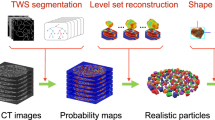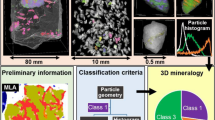Abstract
The liberation and exposure of valuable mineral grains in ore particles are of significant importance in understanding the efficiency of flotation separations. A flotation feed sample from the Kensington concentrator was scanned by micro X-ray computed tomography (micro-XCT), to determine the liberation and exposure of auriferous pyrite grains. The analysis results suggested a satisfying extent of liberation for the particle size below 212 μm. Theoretical flotation recovery of pyrite for selected particle size fractions was predicted from the three-dimensional liberation and exposure analysis. The plant flotation tail was also characterized by micro-XCT to identify liberated and partially liberated pyrite particles that might not be collected into the concentrate. However, liberation analysis of the tail sample revealed that the majority of liberated pyrite were recovered in the plant flotation circuit. Trainable Weka, a machine learning segmentation approach, has been compared with the Watershed thresholding segmentation for the 106 μm × 45 μm particle size fraction scanned at a voxel size of 1.85 μm. Improved segmentation of small particles was found using the machine learning method.
Graphical abstract












Similar content being viewed by others
References
Lin CL, Miller JD, Herbst JA, Rajamani K (1987) Comparison of methods for the measurement of linear grade distributions in liberation analysis. Part Part Syst Charact 4(1-4):78–82
Miller JD, Lin CL (1988) Treatment of polished section data for detailed liberation analysis. Int J Miner Process 22(1-4):41–58
Lin CL, Miller JD (1996) Cone beam X-ray microtomography for three-dimensional liberation analysis in the 21st century. Int J Miner Process 47(1-2):61–73
Gu Y (2003) Automated scanning electron microscope based mineral liberation analysis. J Miner Mater Charact Eng 2(1):33–41
Goodall WR, Scales PJ, Butcher AR (2005) The use of QEMSCAN and diagnostic leaching in the characterisation of visible gold in complex ores. Miner Eng 18(8):877–886
Miller JD, Lin CL, Hupka L, Al-Wakeel MI (2009) Liberation-limited grade/recovery curves from X-ray micro CT analysis of feed material for the evaluation of separation efficiency. Int J Miner Process 93(1):48–53
Miller JD, Lin CL, Garcia C, Arias H (2003) Ultimate recovery in heap leaching operations as established from mineral exposure analysis by X-ray microtomography. Int J Miner Process 72(1-4):331–340
Wang Y, McClung C, Lin CL, Miller JD (2018) Stereological correction of perimeter based estimates of exposed grain surface area. Miner Eng 126:64–73
Pascoe C, Keim R, Haarala P (2021) Kensington Gold Operations Alaska Technical Report Summary, https://www.coeur.com. Coeur Mining, Inc
Videla A, Lin CL, Miller JD (2006) Watershed functions applied to a 3D image segmentation problem for the analysis of packed particle beds. Part Part Syst Charact 23(3-4):237–245
Wang Y, Lin CL, Miller JD (2017) Quantitative analysis of exposed grain surface area for multiphase particles using X-ray microtomography. Powder Technol 308:368–377
Piche N, Bouchard I, Marsh M (2017) Dragonfly SegmentationTrainer-a general and user-friendly machine learning image segmentation solution. Microsc Microanal 23(S1):132–133
Arganda-Carreras I, Kaynig V, Rueden C, Eliceiri KW, Schindelin J, Cardona A, Sebastian Seung H (2017) Trainable Weka Segmentation: a machine learning tool for microscopy pixel classification. Bioinformatics 33(15):2424–2426
Wang Y, Lin CL, Miller JD (2015) Improved 3D image segmentation for X-ray tomographic analysis of packed particle beds. Miner Eng 83:185–191
Hsieh CH (2012) Procedure and analysis of mineral samples using high resolution X-ray micro tomography. PhD thesis. University of Utah
Buades A, Coll B, Morel JM (2005) A non-local algorithm for image denoising. In: 2005 IEEE computer society conference on computer vision and pattern recognition (CVPR'05), vol (Vol. 2. IEEE, pp 60–65
Acknowledgements
The manuscript is prepared to celebrate Prof. Jan D. Miller’s retirement on June 30, 2023, after 55 years of exceptional and dedicated service at the University of Utah.
Funding
This study is funded by Coeur Mining, Inc.
Author information
Authors and Affiliations
Corresponding author
Ethics declarations
Competing Interests
The authors declare no competing interests.
Additional information
Publisher’s Note
Springer Nature remains neutral with regard to jurisdictional claims in published maps and institutional affiliations.
Rights and permissions
Springer Nature or its licensor (e.g. a society or other partner) holds exclusive rights to this article under a publishing agreement with the author(s) or other rightsholder(s); author self-archiving of the accepted manuscript version of this article is solely governed by the terms of such publishing agreement and applicable law.
About this article
Cite this article
Erskine, A.N., **, J., Lin, CL. et al. 3D Characterization of Auriferous Pyrite Flotation Samples for Liberation and Grain Exposure Analysis Using Micro X-Ray Computed Tomography. Mining, Metallurgy & Exploration 40, 1621–1630 (2023). https://doi.org/10.1007/s42461-023-00852-9
Received:
Accepted:
Published:
Issue Date:
DOI: https://doi.org/10.1007/s42461-023-00852-9




